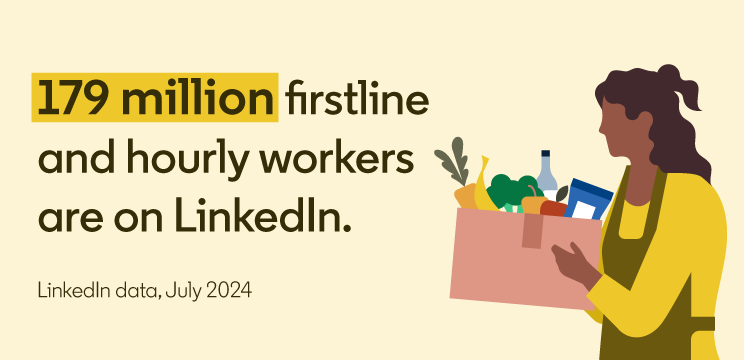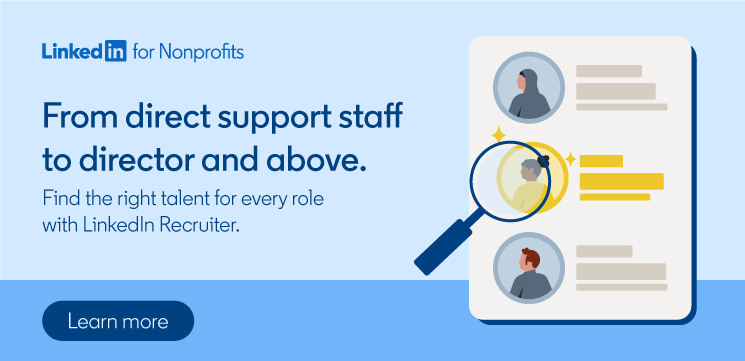
3 Tips for Attracting Nonprofit Frontline Workers on LinkedIn
Recruiting frontline workers is one of the biggest challenges facing nonprofit hiring teams right now. These professionals are an integral part of many nonprofits, but with high turnover and strong competition from other employers, the available talent pool can feel scarce.
The good news is, more frontline workers are on LinkedIn today than ever before. As of July 2024, over 179 million firstline and hourly workers are using the platform — and that number grows every year. In the healthcare sector alone, the number of frontline healthcare workers on LinkedIn has grown by 35% in the past five years.
But how can you attract and hire the frontline talent your nonprofit needs to achieve its mission? Like other professionals on LinkedIn, frontline workers use the platform to grow their careers and connect to opportunities. Follow these tips to ensure your nonprofit is positioning its opportunities effectively to frontline talent.

1. Lead with the skills your frontline workers use the most
Since frontline workers tend to work closest with the communities your nonprofit serves, they’ll likely lean on soft skills like communication, empathy, and adaptability — as well as their technical capabilities and training — every day. That’s why it’s worth emphasizing these skills in your job posts, rather than falling back on the requirements you might usually ask for, like years of experience.
This approach can help candidates quickly identify whether their skill set is right for a role. It can also help you tap into a much wider talent pool. On average, talent pools expand nearly 10x when employers take a skills-based approach to hiring.
You can also adopt a skills-based approach when searching for candidates directly. If you use LinkedIn Recruiter or Recruiter Lite, you can use the Skills filter to identify candidates who list the skills your nonprofit needs on their profile. This can be a good way to find hidden gems who may not have done the exact job you’re hiring for before, but possess transferable skills that would be perfect for the role.
From there, you can reach out to see if they’d be interested in taking their career in an impactful new direction. And once applications start rolling in, you can use the Skills Match feature to quickly filter your applicants and surface those whose skills are a strong fit for the role.
2. List specific shifts and specialities on your job posts
Some frontline roles are a little different than others, and a one-size-fits-all approach to writing job posts may make it difficult for certain workers to determine if a role would be suitable for them. That’s why LinkedIn has rolled out features to make it easier for frontline workers and employers in the healthcare field to find a mutual match.
If you’re hiring for frontline nursing roles in a nonprofit healthcare setting, did you know that you can specify specialities, shifts, schedules, and licenses in your job posts? This allows workers looking for new opportunities to filter their search results based on their skills and needs, ensuring your post reaches more of the right people faster.

If you use LinkedIn Recruiter to source frontline nursing talent in the U.S., you may also have access to the specialities, shifts, schedules, and licenses & certifications filters, empowering you to quickly identify and connect with nurses who have indicated compatible job preferences on their profile.
3. Speak to frontline workers’ interests and goals
Few candidates want to make a strictly lateral move when changing jobs. Many are looking to take the next step in their career, and frontline workers are no different. That’s why it’s important to promote your job opportunities in a way that speaks to these candidates’ interests and goals.
In 2022, McKinsey & Company asked frontline workers about what they consider to be the most important aspects of career advancement. The top five career advancement attributes identified by respondents were:
Job growth (79%)
Pay (78%)
Learning opportunity (75%)
Aligned skill set (75%)
- Supportive manager (73%)
These attributes ranked significantly higher than qualities like a higher job title or recognition from their employer, friends, or family. You can make your open roles stand out by clearly illustrating how your nonprofit can help frontline workers advance their career in the ways that interest them most.
Take learning opportunities. Does your nonprofit make learning resources accessible to both frontline and desk-based employees? This is a priority for the nonprofit Canadian Blood Services, where two-thirds of employees work on the frontlines. To ensure every worker has access to resources that can help them develop their skills wherever, whenever, and on whatever device works best for them, Canadian Blood Services invested in LinkedIn Learning. Of the almost 66% of employees who had activated their licenses in 2023, approximately 38% were frontline workers, indicating the hunger for learning among this employee population.
Once you’ve identified the differentiators you can use to speak to frontline workers’ career interests, weave them into your job posts and the employer branding content you share on LinkedIn. This could include telling authentic stories about how frontline workers have grown their careers at your nonprofit and encouraging hiring managers to post about open roles on their teams to help candidates get to know the people they could be working with.
The bottom line is, frontline workers want the chance to grow their skills and careers in meaningful directions — and they may be willing to switch jobs to find those opportunities. If you can demonstrate that your nonprofit is invested in helping them take their next step and the ones that come after, you can not only attract great frontline workers, but retain them, too.
To find out more about how discounted hiring solutions from LinkedIn can help your nonprofit hire frontline talent, contact our team.

